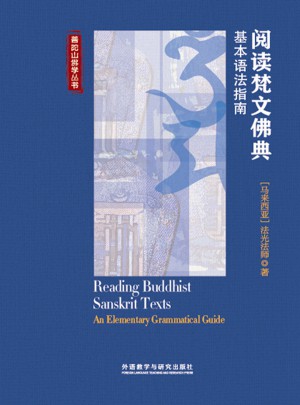
阅读梵文佛典:基本语法指南
- 所属分类:图书 >外语>其他小语种
- 作者:(马来西亚)[法光法师] 著
- 产品参数:
- 丛书名:无
- 国际刊号:9787513566711
- 出版社:外语教学与研究出版社
- 出版时间:2015-11
- 印刷时间:2015-11-01
- 版次:1
- 开本:32开
- 页数:--
- 纸张:胶版纸
- 包装:精装
- 套装:否

阅读梵文佛典:基本语法指南》是法光法师介绍梵文学习的经典之作,也是普通读者入门与研习梵文的佳品。全书由英文写成,但其中参考了诸多中文佛典和梵文经典佛典,篇章分布得当,内容由浅入深,每篇章还配有相应试题练习。作者在书中对梵文经典的结构,梵文单词词性及各种常见的梵文表达方式进行了细致入微的分析。
此书是佛学大师法光法师的倾力之作,书中篇章分部详略得当,并不时加入汉语与梵文的佛典引用,让读者能够对梵文的基本语法结构得到一定地了解。
法光法师(Bhikkhu KL Dhammajoti)系香港大学佛学研究中心教授,佛学原典系的教授和系主任,是研究佛学专科阿毗达磨 (对法)的。精通佛教典籍文字,包括中文古文、梵文、 巴利文、藏文。
Preface
Abbreviations
Lesson 1
1.1 The Sanskrit Alphabet
1.2 Three genders of nouns: masculine (m), neutral (n
and feminine (f
1.3 Three numbers: singular (sg), dual (du) and plural (pl
1.4 Case (vibhakti
1.5 Masculine nouns ending with -a
1.6 Adjectives
1.7 Omission of the verb "to be" in a sentence
1.8 Indeclinable particles ca, vā, api, na and the affix –vat
Lesson 2
2.1 The accusative case (acc
2.2 The ablative case (abl
2.3 Accusative and ablative case of m nouns ending in -a:
buddha
2.4 Neutral nouns ending in -a: phala
2.5 Sanskrit verbs
2.6 Verbal prefixes
2.7 Three grades of strengthening of vowels
2.8 Verbs of classes I, IV, VI, X
2.9 Particle iti
2.10 The emphatic particle eva
Lesson 3
3.1 The dative case
3.2 Genitive used in the dative sense
3.3 Expression of "have"
3.4 The vocative case
3.5 The declensions learned so far
3.6 Declension of f ā-ending noun: praj?ā
3.7 Suffixes -tā, -tva , -tas
3.8 Class VI verbs
3.9 Class IV verbs
3.10 Class X verbs
3.11 Summary of differences between verbs of
class I, IV, VI and X
3.12 Personal pronouns: 1st person stem: mad,
2nd person stem: tvad
Lesson 4
4.1 Declension of m nouns ending in -u
4.2 Declension of n nouns ending in -u
4.3 Declension of pronoun sa? (m) `he`/`that`
and e?a? (m) `this`
4.4 Declension of pronoun tat (n) `it`/`that`
and etat `this`
4.5 The enclitic pronoun enam
4.6 The causative verbs
4.7 The denominatives
4.8 The instrumental case
4.9 Past Passive Participles (PPP
Lesson 5
5.1 Declension of m nouns ending in -i : agni
5.2 Declension of n nouns ending in -i : vāri
5.3 Declension of f nouns ending in -i : jāti
5.4 Declension of f nouns ending in -ī : nadī
5.5 Declension of pronoun sā (f
5.6 Declension of demonstratives: ayam (m),
idam (n), iyam (f
5.7 Declension of interrogative pronouns: ka? (m),
kim (n), kā (f
5.8 The interrogative particles, api and kim
question markers
5.9 Parasmaipada and ātmanepada verbs
5.10 Paradigm for the conjugation of ātmanepada verbs
5.11 Gerunds
5.12 Hard and soft consonants
5.13 Introduction to sandhi rules
5.14 Primary and secondary suffixes
Lesson 6
6.1 Possessive suffix -in
6.2 "Subjective genitive" and "objective genitive"
6.3 Future passive participles (FPP. Also known as
gerundive
6.4 Relatives
6.5 Numerals (cardinals
Lesson 7
7.1 Declension of bhagavant (m
7.2 Possessive suffixes `-mant` and `-vant`
7.3 The Future Tense
7.4 Compounds — dvandva and tatpuru?a
7.5 Infinitive
7.6 Verbs formed from noun/adjective + √bhū and + √k?
7.7 Declension of the demonstrative asau (m
7.8 Declension of the demonstrative ada? (n
7.9 Declension of the demonstrative asau (f
Lesson 8
8.1 Declension of noun ending in –an: ātman, rājan,
karman, nāman
8.2 Class II verbs
8.3 Verb standing at the beginning of a sentence
8.4 The Passive Voice
8.5 Present participles (PrP
8.6 Karmadhāraya compound
8.7 Avyayībhāva compound
Lesson 9
9.1 Declension of manas (n) and sumanas (m,f
9.2 Declension of āyus (n
9.3 Declension of sa?pad (f), vāc (vāk) (f
9.4 Some irregular declensions: grāma?i? (m),pathin (m
9.5 Class IX verbs
9.6 The imperative mood (ipv
9.7 Numbers (ordinal
Lesson 10
10.1 Declension of agent nouns
10.2 Periphrastic Future
10.3 Conjugation of Class V Verbs
10.4 Conjugation of Class VIII Verbs
10.5 The optative mode
10.6 Bahuvrīhi compounds
Lesson 11
11.1 Past Participle Active (PPA
11.2 Conjugation of Class III verbs
11.3 The imperfect tense
11.4 Conjugation of the present and imperfect
of √budh, √j?ā and √dā
11.5 Locative Absolute and Genitive Absolute
Lesson 12
12.1 Class VII verbs
12.2 Conditional tense (condl
12.3 The Perfect Tense (pf
12.4 Comparative and superlative suffixes
Lesson 13
13.1 The Aorist Tense
13.2 Prohibitive (injunctive
13.3 Desiderative and Intensive (/frequentative
English translation of the Vajracchedikā Praj?āpāramitā
Appendix: Sandhi tables
Useful References
Vocabulary
Index
在佛教文化中,有一桩很值得自豪的事业,就是典籍的整理。佛教典籍,作为三宝住世的重要载体,自来受到教界、学界和广大信众的珍视。在佛陀涅槃后不久,就开始了次结集,可以看作是佛教典籍整理的源头。从此之后,结集不断进行。
同时,佛教典籍也在增加,——大乘经典的出现,诸类注疏的繁兴,后世著述的涌现,尽管数量巨大,也都得到不断的整理。只要看看各种不同的《大藏经》,就可以知道佛教典籍整理的成果是何等丰硕了。这些整理工作的成绩令人惊叹。首先,佛教典籍整理的工作遍及宽广的地域,产生了包罗宏富的藏经体系。世界上现存的《大藏经》有巴利语、汉文、藏文三大体系,有巴利语、汉文、藏文、西夏文、蒙文、满文、日文七种文字流传。这还不包括只剩下少数零散贝叶本或纸写本的早期梵文经典,以及虽有刊刻却未见传世实物的契丹文《大藏经》。即使在世界文化史的范围内,也很难看到如此宏富的典籍体系。其次,佛教典籍整理的工作贯穿着长久的历史,各种体系的藏经都在不断地完善着。就汉文《大藏经》来说,至迟在隋代,初期的手写《大藏经》已经流传。同时还有石刻藏经,如房山云居寺就保存有从隋至明的各类石刻经版一万五千余块。印刷术的发明,使得北宋初年就出现了部刻版《大藏经》——《开宝藏》。此后,我国历代官、私所修的《大藏经》,目前已知的计有二十一种。在国外编印的汉文《大藏经》也有九种:朝鲜的《高丽藏》初雕、再雕两种,日本的《弘安藏》《天海藏》《黄檗藏》《弘教藏》《卍字藏》《卍字续藏》《大正藏》七种。目前,大陆和台湾正在分别编纂的《中华大藏经》和《佛光大藏经》,都力图成为能够体现水准的新版《大藏经》。在我国没有任何一部典籍汇编,具有大藏经这样不断完善的历程。比起数十部大藏经来,名闻遐迩的《四库全书》显得孑然孤立。
透过这些整理工作,使我们看到一代代佛教典籍整理者的虔敬和匠心。他们的虔敬,使得藏经的整理不藉外缘。俗话说,"盛世修典",典籍的整理总需要一个太平盛世提供种种物质的支持。但是,藏经的编修却并不如此,即使在乱世,这个工作也不曾停顿。信仰给予了这个工作无量的支持,人世的沧海桑田又何足摇动?他们的匠心,却又使得藏经的整理为善用外缘。只要利于佛教典籍的流传,他们无不择取。贝叶上,纸帛上,碑石上,佛教典籍无处不在。我们在早的纸质印刷品上看到的,是佛经。我们现在能够利用的为完善的中文典籍电子检索系统,是《大藏经》。他们从未错失时运所赋予的机缘。
……
当然,这个设想是过于宏大了,也远远超出了我们目前的实力。但是发一个宏愿,必将有一份动力。我们相信,经过长期不懈的努力,一定能够为佛教典籍的长久流传做一份贡献。何况,普陀山自来就有的文化传统,众多善知识的热心参与,都给了我们信心。同时,我们也热忱期望,有更多的同道来参与这个事业。法门无量誓愿学。学佛法,必然从典籍开始。整理佛教典籍,将是我们中国佛学院普陀山学院义不容辞的责任。
Sādhu
好评!
下次还来买
是英文原版不是译本
不能更赞
书在读着呢,不错,希望当当多搞些活动,O(∩_∩)O。
印刷很好,要细细看。
当你看到这个评论的时候说明我对这个商品是满意的
Sanscrito grammatica
学习学习,了解一下梵文
很好,不错的。
质量还可以。
专业,全面,内容丰富
有兴趣可以看看
推荐购买!
佛教梵语,不是很正的梵文。但是这本书感觉是梵语教材里面最适合自学的,期待早日出汉译本。